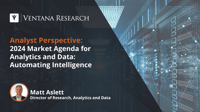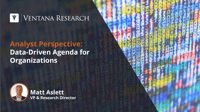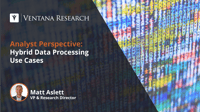The increasing importance of intelligent operational applications driven by artificial intelligence (AI) is blurring the lines that have traditionally divided the requirements between operational and analytic data platforms. Operational data platforms have traditionally been deployed to support applications targeted at business users and decision-makers to run the business, with analytic data platforms typically supporting applications used by data and business analysts to analyze the business.
Read More
Topics:
embedded analytics,
Cloud Computing,
AI & Machine Learning,
Analytics & Data,
analytic data platforms,
Operational Data Platforms
Ventana Research recently announced its 2024 Market Agenda for Analytics and Data, continuing the guidance we have offered for two decades to help enterprises derive optimal value and improve business outcomes.
Read More
Topics:
embedded analytics,
Business Intelligence,
Data Governance,
Data Management,
natural language processing,
data operations,
Process Mining,
Streaming Analytics,
AI & Machine Learning,
Analytics & Data,
Streaming Data & Events,
analytic data platforms,
Operational Data Platforms
When joining Ventana Research, I noted that the need to be more data-driven has become a mantra among large and small organizations alike. Data-driven organizations stand to gain competitive advantage, responding faster to worker and customer demands for more innovative, data-rich applications and personalized experiences. Being data-driven is clearly something to aspire to. However, it is also a somewhat vague concept without clear definition. We know data-driven organizations when we see them...
Read More
Topics:
embedded analytics,
Analytics,
Business Intelligence,
Data Governance,
Data Integration,
Data,
Digital Technology,
natural language processing,
data lakes,
data operations,
Streaming Analytics,
AI & Machine Learning,
digital business,
data platforms,
Analytics & Data,
Streaming Data & Events
I recently described how the data platforms landscape will remain divided between analytic and operational workloads for the foreseeable future. Analytic data platforms are designed to store, manage, process and analyze data, enabling organizations to maximize data to operate with greater efficiency, while operational data platforms are designed to store, manage and process data to support worker-, customer- and partner-facing operational applications. At the same time, however, we see...
Read More
Topics:
embedded analytics,
Analytics,
Business Intelligence,
Data,
Digital Technology,
AI & Machine Learning,
data platforms,
Analytics & Data,
Streaming Data & Events,
Natural Data














